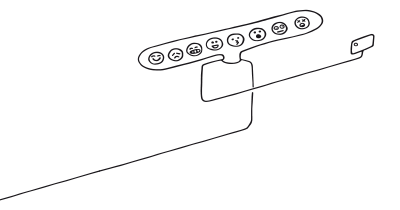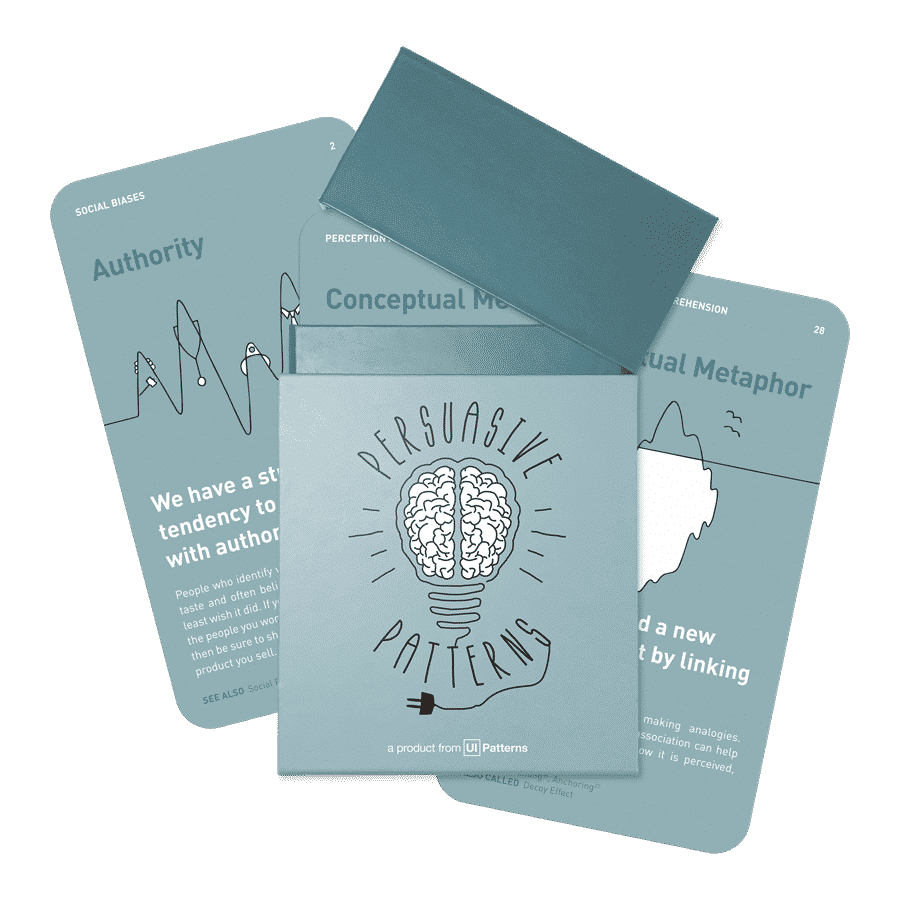Persuasive Technique
See also: Achievements, Conceptual Metaphor, Reputation, Rewards, Self-Expression, Social Proof, Status, Storytelling, Tailoring
This persuasive pattern is part of the Persuasive Patterns printed card deck.
The Persuasive Patterns Card Deck is a collection of 60 design patterns driven by psychology, presented in a manner easily referenced and used as a brainstorming tool.
Get your deck!By enabling users to reflect their identity, this pattern can help enhance user satisfaction and emotional investment, which can lead to increased loyalty and user retention. It is particularly effective in environments where personalization and creativity are valued, contributing significantly to the user’s experience and interaction quality.
The desire for self-expression is a fundamental human need, shaping our behaviors both online and offline. Consider Alice, an avid home cook who meticulously crafts delicious meals for her family. Recently, she discovered a vibrant online recipe-sharing community. While she initially joined to find new recipes, Alice quickly found herself drawn to the platform’s features that allowed her to personalize her profile and recipe posts. Uploading photos of her beautifully plated dishes and sharing her personal recipe adjustments provided Alice with a unique outlet for self-expression. This desire to showcase her culinary skills and creativity mirrored the pride she felt when presenting a home-cooked meal to her family, highlighting the universality of the self-expression motive.
The allure of self-expression extends seamlessly into the digital world. Similar to Alice’s experience, many digital products capitalize on this inherent human desire. Take, for instance, a popular social media platform that allows users to curate their profiles with photos, videos, and biographical details. This platform goes beyond simply connecting users; it empowers them to express their personalities, interests, and values through the content they share. By providing users with a customizable digital canvas, the platform fosters a sense of self-presentation and allows users to craft an online identity that reflects who they are.
The study
In their seminal study, Vazire and Gosling (2004) focused on analyzing how the personal websites of individuals reflect their personalities, a concept they termed as “e-Perceptions.” The researchers used established personality assessment tools to profile website owners and then compared these profiles with the characteristics discernible from their websites’ content and design. They found that certain website characteristics—such as the amount of information shared, aesthetic design, and the topics discussed—were consistent indicators of specific personality traits.
They found that websites with eclectic content, varied multimedia, and creative design elements were typically owned by individuals scored high on openness. Also, more structured, well-organized, and frequently updated websites tended to reflect owners who were more conscientious. Those websites with vibrant colors, numerous social links, and frequent updates generally belonged to more extroverted individuals.
This research substantiated the notion that personal websites are not only digital spaces for information sharing but also platforms for complex personal expression and identity management. Their study provided empirical support for using website design elements as psychological indicators, offering a foundational understanding of how digital spaces can mirror real-world personality traits.
Vazire, S., & Gosling, S. D. (2004). e-Perceptions: Personality impressions based on personal websites. Journal of Personality and Social Psychology, 87(1), 123-132.
The human desire for self-expression is deeply ingrained, shaping our actions from a young age. Consider a child’s excitement when they proudly display a finger-painted masterpiece or a teenager’s meticulous curation of their clothing and style. These seemingly simple acts highlight our inherent need to express ourselves and communicate our individuality to the world. This fundamental human drive is precisely what the “Self-Expression” pattern in design taps into.
At its core, the Self-Expression pattern leverages the psychological principle of identity formation. This principle emphasizes the ongoing process of developing a sense of self, encompassing our beliefs, values, and unique characteristics. Self-expression serves as a critical tool in this process, allowing us to explore different facets of ourselves and communicate them to the world.
The concepts of self-concept theory and self-determination theory are important pillars. These theories suggest that individuals have an inherent need to express themselves in ways that reinforce their sense of identity and autonomy.
Self-concept theory posits that people have an organized understanding of themselves, which influences and is influenced by their actions. When individuals express themselves, whether through language, art, or behavior, they are not just communicating to the outside world but also affirming their own self-concept.
Self-determination theory (Deci & Ryan), on the other hand, emphasizes the role of autonomy, competence, and relatedness in motivating behavior. This theory suggests that the opportunity for self-expression allows individuals to fulfill their need for autonomy, enhancing their motivation and engagement. When users can tailor their interactions or environments to reflect their personal tastes and preferences, it reinforces their sense of control and personal relevance, thereby increasing engagement and satisfaction.
In the context of product design or digital interaction, facilitating self-expression can be a powerful tool to enhance user experience. When products or systems are designed to allow users to customize or personalize aspects of their experience, it taps into their intrinsic motivation, making the activities more meaningful and engaging.
Designing products by allowing Self-Expression
Craft environments that allow users to showcase their identity, preferences, and creativity. By tapping into the innate desire to represent oneself uniquely and authentically, this pattern can help enhance user engagement and loyalty.
Offer customization options that allow users to alter the aesthetics and functionality of the interface according to their preferences. This could involve allowing users to change color themes, layouts, or even functionality of the app or website. For example, a social media platform might enable users to customize their profile layouts and color schemes, which not only personalizes the experience but also gives them a sense of ownership over their digital space.
Facilitate platforms or features where users can create and share their content. This could be through blogs, video uploads, or customization of digital items. For instance, a gaming platform can allow users to create and share their game levels or character designs. By providing tools for creation, you encourage users to express themselves and engage more deeply with the product. Create a sense of community within your product by fostering user interaction. This could involve features like forums, comment sections, or social feeds where users can connect, share ideas, and express themselves in a social setting.
Acknowledge and celebrate user-generated content and active participation. Consider featuring user creations, awarding badges for contributions, or offering exclusive features to highly engaged users. This positive reinforcement encourages continued self-expression and motivates users to invest in the community. Incorporate elements that reflect the user’s achievements and milestones. This can be done through badges, trophies, or progress bars. Such features should celebrate personal achievements that are meaningful to the user and recognized by their peers. In educational apps, this might look like badges for completing challenging modules, or in fitness apps, trophies for reaching fitness goals.
Social interactions can amplify the effect of self-expression by validating the user’s identity and creations through community engagement. Features like comments, likes, and shares can validate and reinforce the user’s sense of self within a community. Ensure these features are designed to promote positive reinforcement and constructive feedback.
Use data intelligently to offer personalized experiences. This goes beyond aesthetic customization to adapt the functional aspects of the product based on the user’s behavior and preferences. For instance, if a user frequents certain topics on a news app, the app could start highlighting similar content more prominently, effectively tailoring the experience to the user’s interests.
While encouraging self-expression, it’s crucial to maintain community standards. Clearly communicate what forms of expression are encouraged and which might be inappropriate or offensive.
Not all users express themselves in the same way, providing different tools and options, such as text, video, or image-based content creation, to cater to different preferences and abilities.
Foster a community environment that encourages positive feedback and constructive criticism, which can enhance user satisfaction and encourage continued participation.
Ethical recommendations
While fostering personalization and engagement, promoting extensive self-expression without moderation holds potential for misuse. If not properly managed, it can lead to environments where harmful content is expressed under the guise of personal freedom. This can include hate speech, bullying, or the spread of misinformation, which can damage community welfare and individual well-being. Additionally, platforms that allow unfettered self-expression without clear guidelines or moderation can inadvertently promote echo chambers, where only popular opinions are reinforced, stifling diversity and discourse.
To ensure that the self-expression pattern is used ethically and remains user-centric, consider the following best practices:
- Implement robust moderation
Develop and enforce clear community guidelines that define acceptable forms of expression. Utilize both automated tools and human moderation to oversee user-generated content, ensuring it aligns with these guidelines. - Promote positive interactions
Encourage a community culture that values respectful and constructive communication. Highlight and reward examples of positive interactions and contributions that enhance communal understanding and enrichment. - Educate users
Provide users with resources that help them understand the impact of their words and actions online. Educate them about the community guidelines, the importance of respectful discourse, and the consequences of violating policies. - Ensure transparency
Be transparent about how data generated through self-expression is used. Users should be aware if their content is being monetized, used for training AI, or influencing their user experience in any way. - Provide opt-out options
Allow users to control how much personal information they share and how they engage with the platform. Providing settings that let users manage their privacy and the extent of their engagement can help maintain a sense of autonomy. - Support user anonymity when appropriate
While real-name policies can foster accountability, they might also stifle honest self-expression, especially in sensitive contexts. Offering the option for anonymity can empower users to share without fear of undue repercussions.
It is critical to foster an environment where self-expression enhances the user experience without compromising safety or community integrity. This balance is important for maintaining a platform that is both engaging and respectful of individual and collective boundaries.
Examples
Etsy
Provides a marketplace for artisans to sell unique, often handmade items, which not only supports their creativity but also allows buyers to find items that express their individual tastes.
Roblox
This online gaming platform allows users to design and build their own virtual worlds. This feature empowers users to express their creativity and ingenuity, fostering a sense of ownership and pride in their creations.
Spotify Playlists
This music streaming platform allows users to create and share their own playlists. These playlists can be themed, genre-specific, or simply reflect a user’s current mood. Sharing playlists becomes a way for users to express their musical tastes and connect with others who share similar interests.
Trigger Questions
- What opportunities can we provide for users to express their unique style and personality?
- How can we empower users to create and share content that reflects their interests and passions?
- What features would foster a sense of community and encourage user interaction?
- How can we create a system that rewards and celebrates user-generated content and active participation?
- Are the customization options we offer truly meaningful and impactful for user self-expression?
- How can we ensure our content creation tools are user-friendly and accessible to a broad range of users?
- How do we ensure the customization options align with our user's core needs and values?
- Are the levels of personalization we're providing appropriate for our user base's technical skills?
- What methods will we use to measure the impact of self-expression features on user engagement and satisfaction?
- How can we encourage users to explore and use customization features without feeling overwhelmed?
- In what ways can we allow users to share their personalized experiences to enhance community building?
- What feedback mechanisms can we implement to refine and evolve our self-expression features?
Pairings
Self-Expression + Social Proof
People are often influenced by the actions and preferences of others. Combine self-expression with social proof by allowing users to share their creations with a wider community. Imagine a photo-sharing app that integrates a “Trending Styles” section showcasing the most popular user-generated content. This combination taps into the desire for self-expression while simultaneously leveraging social influence to inspire further creative exploration within the app.

We seek opportunities to express our personality, feelings, or ideas

We assume the actions of others in new or unfamiliar situations
Self-Expression + Rewards
Rewarding users for their expressive activities encourages ongoing engagement. For instance, digital platforms might offer badges or unlockable content as rewards for user participation in community challenges, enhancing both the sense of achievement and personal expression.

We seek opportunities to express our personality, feelings, or ideas

Use rewards to encourage continuation of wanted behavior
Self-Expression + Achievements
Gamification techniques like points, badges, and leaderboards can motivate users and encourage continued engagement. Pair self-expression with gamification by rewarding users for creating and sharing high-quality content. This approach seen in platforms like Duolingo, with its gamified language learning experience, incentivizes users to express their progress and compete with others, fostering a sense of accomplishment and community. Encouraging users to express themselves through content creation or community interaction and rewarding them with achievements can create a powerful motivational loop. YouTube does this by recognizing creators with different ‘Creator Awards’ as they reach subscriber milestones.

We seek opportunities to express our personality, feelings, or ideas

We are engaged by activities in which meaningful achievements are recognized
Self-Expression + Tailoring
Tailoring allows users to personalize the product experience to their unique preferences. This complements self-expression by providing users with a greater sense of ownership and control. For instance, a fitness app that allows users to create custom workout routines not only personalizes the experience but also empowers users to express their fitness goals and preferences.

We seek opportunities to express our personality, feelings, or ideas

Adapt the offerings of a system to match individual users- needs and abilities
Self-Expression + Status
Allowing users to achieve status through expressive activities can motivate continued engagement. This is evident in platforms like LinkedIn, where users enhance their professional status by sharing articles, insights, and achievements, reflecting their professional identity and expertise.

We seek opportunities to express our personality, feelings, or ideas

We constantly look to how our actions improve or impair how others see us
This persuasive pattern is part of the Persuasive Patterns printed card deck.
The Persuasive Patterns Card Deck is a collection of 60 design patterns driven by psychology, presented in a manner easily referenced and used as a brainstorming tool.
Get your deck!- Self-determination theory and the facilitation of intrinsic motivation [ by Ryan & Deci
- Individuality by Grey
- Wellman, B., & Boyd, D. (2002). Networks of structure, value, and meaning: A framework for understanding the social capital of computer supported interaction. In B. Wellman & D. Kathleen (Eds.), The internet in everyday life (pp. 18-31). Oxford University Press. [3]
- Papacharissi, Z. (2010). Affective publics: Sentimentality in the age of social media. Oxford University Press.
- Erikson, E. H. (1968). Identity: Youth and crisis. W. W. Norton & Company.
- Schlenker, B. R., & Weigold, M. F. (1992). Self-presentation and social facilitation: Theory and research. Psychological Bulletin, 112(1), 161–228.
- Jourard, S. M. (1964). The transparent self. D. Van Nostrand Company.
- Zhao, S., Grasmuck, S., & Martin, J. (2008). Identity construction on Facebook: Digital empowerment in anchored relationships. Computers in Human Behavior, 24(5), 1816-1836.
- Gardner, H., & Davis, K. (2013). The App Generation: How Today’s Youth Navigate Identity, Intimacy, and Imagination in a Digital World. Yale University Press.
- Vazire, S., & Gosling, S. D. (2004). e-Perceptions: Personality impressions based on personal websites. Journal of Personality and Social Psychology, 87(1), 123-132.
- Deci, E. L., & Ryan, R. M. (1985). Intrinsic motivation and self-determination in human behavior. Psychological Inquiry, 3(4), 319–348.
- Bandura, A. (1977). Self-efficacy: Toward a unifying theory of behavioral change. Psychological Review, 84(2), 191–215.
- Ryan, R. M., & Deci, E. L. (2000). Self-determination theory and the facilitation of intrinsic motivation, social development, and well-being. American Psychologist, 55(1), 68-78.
- Aristotle. (c. 338 BCE). Rhetoric. Translated by W. Rhys Roberts (1924). Oxford University Press.
- Goffman, E. (1959). The presentation of self in everyday life. Doubleday Anchor Books.
- Ryff, C. D., & Keyes, C. L. (1995). The structure of psychological well-being revisited. Journal of Personality and Social Psychology, 69(1), 719.
- Lockwood, A. L., & Kunda, Z. (1997). Superstars and me: When personal experience enhances or undermines the persuasiveness of social messages. Journal of Personality and Social Psychology, 72(2), 101–115.
- Grey, A. (1993). Individuality, conformity and collective identity. International Forum of Psychoanalysis, New York, USA, 9–12.
